Don’t let a Dachshund’s silly look and demeanor fool you – this breed is highly intelligent, driven, and courageous.
These breed qualities leave many potential owners wondering, are Dachshunds easy to train?
Can a Dachshund be Trained?
Dachshunds were originally bred back in the 15th century, when they were used to hunt small game such as badgers, foxes, and boar.
Because of their prey drive, willingness to persevere, and inclination to think on their own, some Dachshund owners have regarded the breed as “hard to train.”
The breed is highly independent and tends to be mischievous, leading Dachshund owners to think that their dog is stubborn or unwilling to learn. However, this is not the case.
With consistency and patience, the Dachshund can be as easy to train as any other breed.
Dachshunds are whip smart. They are eager to learn, especially when being rewarded with positive reinforcement, and typically quick to figure out what you want them to do.
Dachshund owners may think their dog is not willing to learn, but they can be trained.
Since these dogs inherently want a job to do or prey to hunt, they will be on the lookout for opportunities to successfully complete a mission.
In this case, the mission is training!
So, can a Dachshund be trained? Absolutely!
In this article we’ll cover just exactly how easy it is to train a Dachshund.
We also have tips and tricks for making training your Dachshund fun and successful.
Why Do Dachshunds Have a Reputation for Being Difficult to Train?
It’s true that Dachshunds can be difficult to housebreak or potty train.
It’s completely possible to do so but it can take more dedication, consistency, and time than a lot of other dog breeds.
Because the Doxie is notorious for not being easy to potty train, people often think they are difficult to train at all.
However, teaching them basic obedience and tricks is a different scenario.
This lively breed will respond to consistent, positive reinforcement training just as well as other common breeds. The key is repetition.
If your Dachshund is not interested in what you’re trying to teach them, it’s probably because the task isn’t clear, challenging enough, or engaging.
Make sure the task
It could also be that they are in an environment that is too distracting.
Your Dachshund is much more likely to pay attention to the squirrel outside the window during a training session if you don’t make it exciting and rewarding.
5 Tips for Training a Dachshund
Now, what do you do if your Dachshund seems completely bored by your attempt to teach them a new trick or skill?
Try these suggestions:
1) Make sure you are using positive reinforcement training
You should never punish or scare your Dachshund by yelling or physically pushing them down to lay or sit.
This will only set back your training, and the bond you have with your pup.
Ultimately you want your Doxie to trust you, not be afraid of you. Ideally, they will WANT to do what you want.
2) Make sure you are using a reward they can’t resist
If the reward you’re offering doesn’t spark excitement for your Dachshund, try something else!
You can change the type of treats you’re using for training.
Use a irresistible reward so your Dachshund is more motivated to learn.
Instead of offering dog treats, use a high-value reward such as chicken, cheese, or their favorite meat.
High-value treats are excellent for teaching a new skill or trick.
If your furry friend isn’t food motivated, try using a quick game of fetch with their favorite toy and a lot of praise.
3) Eliminate other distractions from your training environment
If your Dachshund is spotting prey out the window, close the blinds or move to a room where they can’t be distracted by the outdoors.
Ideally, you can train in a place where there are no other people in the room (at least at first) so your dog’s focus is only on you.
Once your dog can focus on only you and what you are asking them to do, training will become easier.
4) Keep training sessions short
A 30-minute training session may be too much for your excited Dachshund.
It’s okay to keep training sessions to 5 minutes or less. In fact, doing several 5-minute lessons throughout the day has proven to be a highly successful way to train a dog.
Training sessions that last for only 5 minutes can be just as effective, if not more, as longer sessions.
Dragging it out if your pup isn’t focusing won’t do either of you any good.
It’s crucial to read your Dachshund’s body language. If they are frustrated, take a break.
5) Be Consistent
The trainability of a Dachshund is no more or less than any other dog breed. These small pups can easily be trained with plenty of repetition and consistency.
Your Dachshund probably won’t successfully learn something if you teach it one time and never practice it again, but no dog would!
While you can work on training several different commands at once, try to stick with the same few regularly and only move on once your dog has caught on.
The Too Long, Didn’t Read Version
Dachshunds are definitely trainiable.
The breed in general is fairly agreeable with an alert and responsive personality for effective training.
Utilizing the following tips will help ensure successful training for years to come:
- We always encourage the use of positive reinforcement training. Avoid using items such as shock collars on your Dachshund if at all possible.
- Consider using a high-value treat for training sessions, such as chicken, cheese, or your dog’s favorite (safe) human snack.
- Keep training sessions short (5-10 minutes per session) and exciting with plenty of treats and praise.
- Practice the new skill or trick every single day, perhaps even multiple times a day. You can make sessions as short as 30 seconds! Any repetition will be beneficial.
- Train your Dachshund in a distraction-free environment. A Dachshunds Dachshund’s focus can wander, especially if they feel that the squirrel outside the window is more exciting than what you’re offering.
- Be patient and have fun! If you get frustrated during training, stop the session. It’s better to take training slowly if necessary, rather than having to go back and correct behavior.
What Do You Need to Train a Dachshund?
Dog treats are essential when training a Dachshund but there are a couple of other things that will make the process easier.
Note: some of the links below are affiliate links, which means that we receive a small commission if you make a purchase.
All you really need to train a Dachshund is time and patience.
However, there are some tools that can help make training sessions more enjoyable and effective.
Some of those things are:
Training Treats
Because Dachshunds are small dogs, and you will be giving them a lot of treats during a training session, it’s best to choose small, low-calorie treats.
However, the treat must also be “high value” to hold your Dachshund’s attention and motivate them to do what you want.
You may need to experiment with a few different treats to see what works.
Also, switching treats up for each session, or halfway through one session, will help keep them engaged.
Some great treats for training Dachshunds are:
- Zukes Mini Naturals – These are made with only whole food, natural ingredients and are crafted in the USA. Each treat contains approximately 3 calories and can easily be broken in half to make each treat 1.5 calories.
- Redbarn Pet Products Protein Puffs Cat – These baked treats are made of natural ingredients and have lots of protein. They’re less than 1 calorie per bite.
- Crumps’ Naturals Mini Trainers Freeze Dried Beef Liver – Made with just a single ingredient (beef liver), these complement a raw food diet. These low-calorie treats are made in Canada.
- Human food – I usually don’t recommend feeding “junk” human food to dogs but in small quantities, if it helps one accomplish their training goal, it’s ok. Some examples of human food that can be cut into tiny pieces and used for dog training treats are string cheese and hot dogs.
Training Treat Pouch
One of the keys to quick and efficient training is to give your dog the treat as soon as you can to the moment they do the thing you’re asking them to do.
Having the rewards where you can quickly grab them is most easily accomplished by wearing a treat pouch around your waist (it’s best if it’s positioned slightly behind your back so your dog doesn’t immediately see the treats and expect one).
Two of my favorite training treat pouches are:
- Ruffwear Treat Trader Pouch – It’s deep enough to hold a lot of treats, clips around your waist using an included webbing belt, has an easy-access magnetic closure, and pulls open quickly by grabbing a red tab on the outside.
- OllyDog Goodie Dog Treat Bag – This treat bag can be worn 3 ways – clipped on to a belt loop or pocket, using the removable waist-belt, or attached to the owner’s belt through the tunnel fabric – and has a magnetic closure, wide opening, and a zippered stash pocket.
A Clicker for Marking Behavior
The concept of a clicker, versus using your voice, is that it produces a precise sound at the precise moment your dog does the thing you want them to do.
A “marker” is needed to let your dog know the exact moment they have done the right action. A verbal “Yes!” can be used as a marker word but a clicker is often more effective.
This way they learn, more quickly, exactly what they should do when you say the command. Once they have the command down reliably, you can phase the clicker.
I use the StarMark Clicker because it makes the sharpest, loudest noise and has not started to wear out or gotten quieter with a lot of use.
Final Thoughts
If you’re looking for a dog breed based somewhat on their trainability, the Dachshund probably falls in the middle of the spectrum. It’s easy to teach a Dachshund most things.
However, it may be more important to consistently present learning opportunities for your Dachshund than some other breeds.
I always say that a Dachshund can unlearn something as quick as they learned it.
If you start being lax with enforcing learned training, or let them get away with something you normally don’t, they will remember that ONE TIME they didn’t have to do what you asked.
The key to a well-behaved Dachshund is being consistent and giving them opportunities to practice their training, or learn new skills, throughout their lifetime.
Also, the “rumor” that Dachshunds are hard to potty train is a reality more often than not.
But, remember that the difficulty with potty training typically does not transfer over to other types of obedience training.
With plenty of consistency, high-value treats and patience, your pup can learn some big tricks to impress all of their friends at the park!

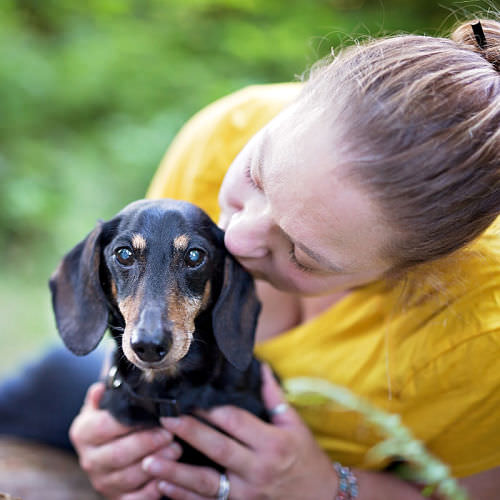
About the Author: Through her 17 years of owning and caring for Dachshunds, and almost 10 years researching and writing about them, JW has become a respected expert in the Dachshund community. Read more about her here.


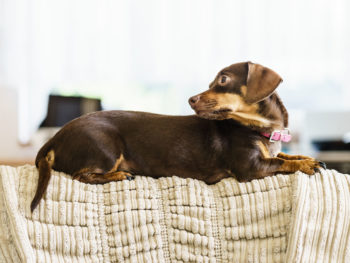


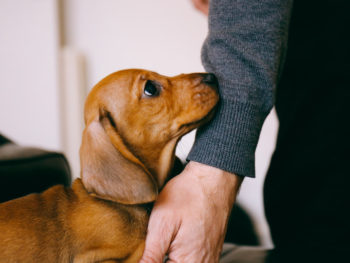
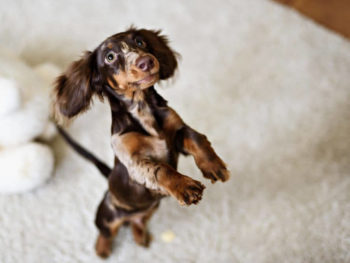




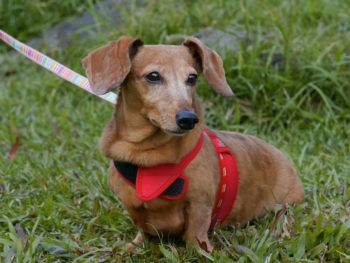

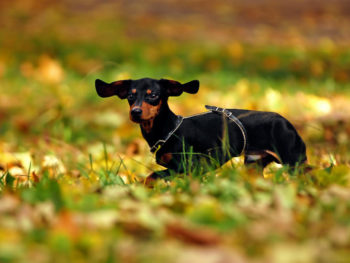
 Why Do My Dachshund’s Feet Smell Like Fritos?
Why Do My Dachshund’s Feet Smell Like Fritos?


